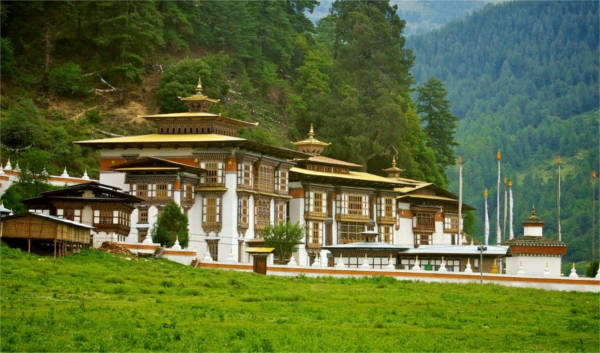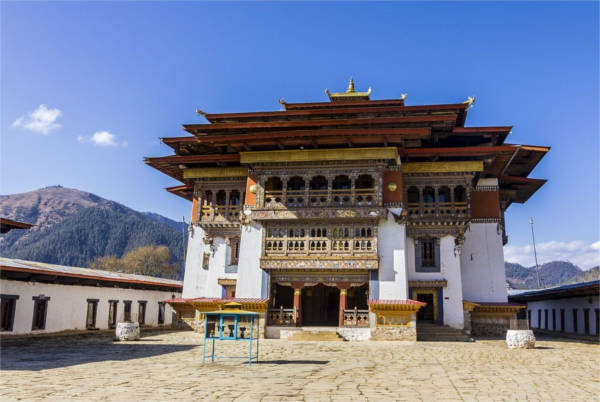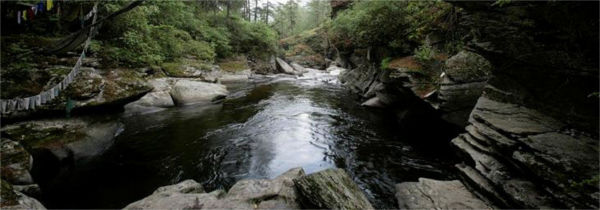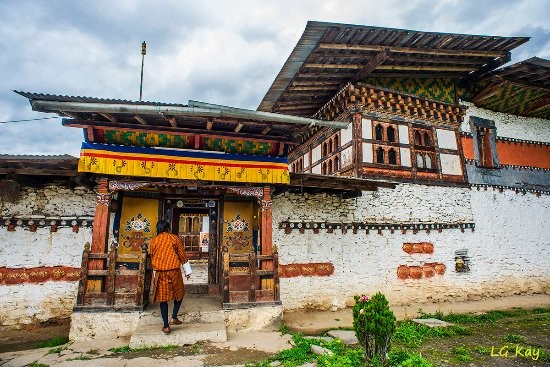Bumthang District

Kurje Lhakhang (Body Impression)
The site has three temples which has a body impression of Guru Rinpoche left behind after he meditated there and subdued evil spirits the chief of which was Shelging Karpo. Kurje means body impression. Guru Rinpoche visited Bumthang in 746 AD at the invitation of the local king, The Chakhar Gyalpo. The oldest temple was built in 1652 by Chogyal Migyur Tenpa, the first Choetse Chila (governor of Trongsa province). The second temple was built in 1900 by the first King Gongsa Ugyen Wangchuck on the spot where Guru left his body imprint, and the third temple was built in the 1990s under the commanded of Queen Mother Ashi Kesang Choeden Wangchuck. The first, second, and the third temple contain respectively the three Buddhas (the past, present, future), a 12-metre tall statue of Guru Rinpoche, and Khenlop Chosum (Guru Rinpoche, King Thrisong Duetsen, and Pandit Santarakshita).
Koenchosum Lhakhang.

The origin of the temple likely has its roots in the 7th century AD. The current structure, however, dates from the 15th century, when Terton Pema Lingpa restored it. It is believed that a large lake existed underneath the site where Terton Pema Lingpa discovered several treasures, and later built the temple atop it. The small statues of the three Buddha’s (past, present and future) in the sanctuary, are believed to have flown to the site (where the temple is built today) all the way from Khini Monastery in Kurtoe. Hence the name, ‘Kenchosum’: Kencho meaning divine and Sum meaning three. There is a stone pedestal in the courtyard of the temple, upon which a large ancient bell is kept. Legend has it that the bell, when rung, could be heard as far away as Lhasa in Tibet. In the 17th century, Tibetan troops tried to steal the bell. The bell being too heavy for the troops to carry was dropped and suffered a crack.
The bell can still be seen inside the temple, and is considered as one of the main artefacts of the temple. The monastery also holds many relics. The central figure in the temple is the Vairocana (also known as the Nammang, the Buddha of vast space). Towards the left are the Avaloketeshvara and a statue of Guru Rinpoche to the right. The main relic of the monastery is Jowo Jampa (Lord Buddha).
Mebar Tsho(Burning Lake)

Mebar Tsho, meaning Burning Lake is the sacred lake from where Terton Pema Lingpa discovered treasures as directed by Guru Rimpoche. Terton in front of villagers who has come to witness has jumped into the lake with a burning butter lamp in his hand. He miraculously emerged from the lake after some time with a chest and a scroll of paper and the butter lamp still burning. Therefore, the lake came to be known as Mebar Tsho.
Jampa lhakhang
Jambay Lhakhang is said to be one of the 108 temples built by the Tibetan King Songtsen Goenpo in 659 AD on a single day to pin down an ogress to earth forever. When Guru Rinpoche came to Bhutan, it is said that he preached the teachings of the Kagye cycle to King Sintu Raja and his court from the roof of the temple. The temple of Jambay Lhakhang was later restored by Sendhu Raja after Guru restored his life force.
Tamshing Lhakhang (Temple of the Good Message)

Tamshing Lhakhang is also known as Tamshing Lhendup Chholing , is at the northern end of the road and facing toward the Kurje Lhakhang. It was established in 1501 by Terton Pema Lingpa and is the most important Nyingma Goemba in the Kingdom. Pema Lingpa built the structure himself , with the help of Khandroms(female celestial beings) who made many of the statues.

